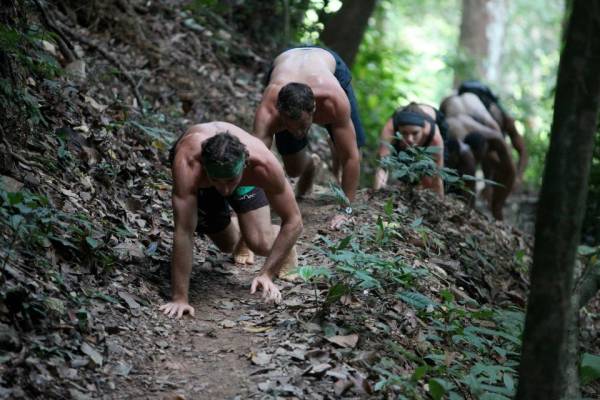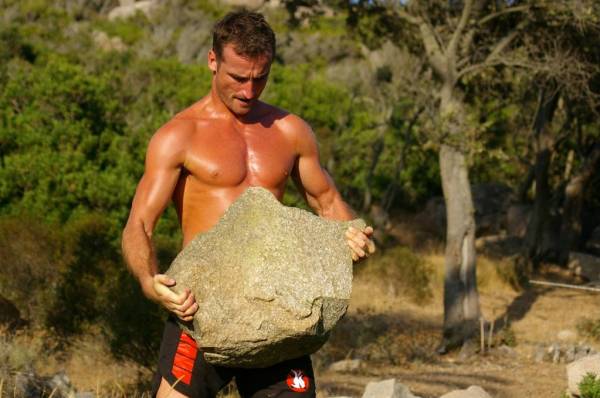MovNat is a physical education and fitness system that is entirely based on natural movement skills, mainly including locomotive and manipulative skills, but also combative ones.
Benefits of MovNat:
- Improved mobility.
- Improved stability.
- Improved movement skills.
- Improved balance.
- Improved focus.
- Improved applicability of the strength you already possess.
- Improved physical competence for practical performance.
- At the end of the day, that makes a whole lot improved you.
MovNat is a school of physical competence for practical performance. To us, physical competence is for the real world and involves the symbiotic development of movement skills and physical conditioning both. If we were to use a metaphor, making the body stronger is like getting stronger hardware – but the movement skills are the software essential to be able to use the hardware. You can’t make one work without the other.
Let’s take an example from a classic strength and conditioning standpoint. A pull-up is an upper body strength conditioning drill. To us, from the perspective of MovNat, it is primarily a component of a particular climbing action. While being able to perform several pull-ups in a row is certainly an essential aspect of overall fitness criteria, it doesn’t necessarily automatically make you a great climber. To be good at climbing, it will require from you both the climbing skills and the specific conditioning necessary to perform every particular climbing technique effectively.
That specific conditioning, how do you acquire it? Through isolation drills that don’t even resemble climbing patterns, or mostly through the practice of those varied movement patterns, or through conditioning drills that closely resemble the type of movement and effort you will need perform? That’s right. Conditioning is specific to the type of physical action you need to perform. If you were to apply this reasoning to every real world physical action you’d like to be able to perform effectively and efficiently, i.e. with physical competence, general conditioning might not suffice if skill practice is missing.
This simple observation explains the MovNat approach to strength and conditioning. Indeed, we make sure to primarily condition through the practice of movement skills in a progressively challenging manner. Rarely do we dissociate the two, except if we need a particular emphasis for a specific outcome.
What are the practical applications of training heavy lifts? Probably the ability to carry heavy stuff, right? It implies that to be adept at manipulating, i.e. moving external objects through space, you are very likely to need to be adept at locomotive skills as well, and actually in the first place. If I was to put it bluntly, before you can move “heavy shit,” you must be able to move the “heavy shit” that you are. No offense, I guess you got my point.
 We all have to move our whole body mass everyday throughout our entire lives, correct? It means that locomotive skills precede manipulative ones, and if you want to excel at manipulating – heavy – loads, including carrying them through complex environments, you will need to make sure you can perform unloaded movement patterns with sufficient ease and control. Yes, the ability to move your own body well comes first, always. In a nutshell, moving and manipulating loads is a skill that requires not only strength, but also and primarily a functional body that is mobile, supple, and flexible. Unless you want to put the cart before the horse, but does that take you far?
We all have to move our whole body mass everyday throughout our entire lives, correct? It means that locomotive skills precede manipulative ones, and if you want to excel at manipulating – heavy – loads, including carrying them through complex environments, you will need to make sure you can perform unloaded movement patterns with sufficient ease and control. Yes, the ability to move your own body well comes first, always. In a nutshell, moving and manipulating loads is a skill that requires not only strength, but also and primarily a functional body that is mobile, supple, and flexible. Unless you want to put the cart before the horse, but does that take you far?
Maybe the most frequent issue “strength seekers” are dealing with is an all-around lack of mobility. Those limitations not only easily reduce your ability to put your strength to use for practical performance, but also can cause a series of related injuries. I know, “mobility drills” can be easily disregarded and then discarded because they often sound or look boring, as if they were optional. The point is, they’re not.
So here’s the deal: the drills I present in this 4-week plan are not mobility drills. They are actually natural, useful, adaptive movements that happen to improve mobility when you practice them frequently. Conversely, you happen to lose mobility when you stop practicing them because of the comfort of modern life or the specificity of your fitness regimen has rendered them accessory – or so it seems. Got the point? Such movements are not optional; they are a biological duty for your body to remain fully functional. So please, give those natural movements a chance. What looks like “mobility drills” at first will soon evolve towards natural, practical, and adaptive movements that will challenge your strength in unexpected ways. And you might catch yourself enjoying them! Or maybe even finally acknowledging their value and importance.
 If this makes sense to you, then this 4-week MovNat training plan is for you! And if it doesn’t, then please, give it a shot still.
If this makes sense to you, then this 4-week MovNat training plan is for you! And if it doesn’t, then please, give it a shot still.
Maybe you will find new challenges and reap new benefits in the process. Do you possess physical competence for the real world? Can you put your muscles and strength to real use? Try this plan and you will find out.
By Erwan Le Corre
Founder of MovNat and Master Instructor
Click here to get started on your four weeks of free MovNat workouts.
To learn more about Erwan, read our feature interview:
Featured Coach: Erwan Le Corre, Part 1 – The Roots of MovNat
Featured Coach: Erwan Le Corre, Part 2 – Freedom of Movement and Mind






